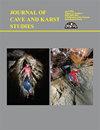洞穴探险进入病毒圈:表征卡尔斯巴德洞穴国家公园的病毒群落
IF 0.5
4区 地球科学
Q4 GEOSCIENCES, MULTIDISCIPLINARY
引用次数: 0
摘要
病毒是地球上最丰富的生物实体,在环境和生物圈中起着至关重要的作用。主要在海洋环境中进行研究,病毒被量化为病毒样颗粒(VLP),其流行率是细胞的10-100倍。它们有助于养分循环,调节微生物种群,并有助于海洋沉积物的形成。虽然大多数病毒研究工作都集中在海洋中,但还没有在公开参观的洞穴中进行过这样的调查。在这里,我们对卡尔斯巴德洞穴国家公园的四个洞穴池中的病毒群落进行了表征,以测试以下假设:i)病毒丰度比洞穴池中的原核细胞丰度高10倍,(ii)洞穴池中含有新的病毒序列,以及(iii)洞穴发达部分池中的病毒群落与同一洞穴未开发部分池中的病毒群落不同。病毒和微生物丰度之间的关系是通过直接荧光显微镜计数确定的。构建病毒DNA宏基因组以检测病毒池间的多样性并鉴定新型病毒。辅助代谢基因(AMGs)也被鉴定用于池的表征。VLP和微生物定量测定洞穴病毒与细菌的比例为22:1,与海洋研究结果一致。确定病毒丰度与池流量无关。根据覆盖概况的统计分析,发现流量较高的池之间的相似性比访问量较少的池更大。基因共享网络分析显示,与参考病毒数据库和其他水生环境相比,病毒多样性较高。AMG的存在在4个池中显示出代谢势的差异。总的来说,卡尔斯巴德洞穴在不同的池中藏匿着各种各样的新型病毒。未来的工作将研究病毒-宿主相互作用和RNA病毒。本文章由计算机程序翻译,如有差异,请以英文原文为准。
Spelunking into the Virosphere: Characterizing Viral Communties from Carlsbad Caverns National Park
Viruses are the most abundant biologic entities on Earth, and they play a critical role in the environment and biosphere. Primarily studied in marine environments, viruses, quantified as viral like particles (VLP), have been found to be 10-100 times more prevalent than cells. They contribute to nutrient cycling, regulate microbial populations, and aid in the formation of marine sediments. While most viral research efforts have been focused in oceans, no such investigation has been performed in publicly toured caves. Here, we characterize viral communities in four cavern pools in Carlsbad Caverns National Park to test the hypotheses that i) viral abundance is ten-fold higher than prokaryotic cell abundance in cavern pools, (ii) cavern pools contain novel viral sequences, and (iii) viral communities in pools from developed portions of the cave are distinct from those of pools in undeveloped parts of the same cave. The relationship between viral and microbial abundance was determined through direct epiflorescent microscopy counts. Viral DNA metagenomes were constructed to examine viral diversity among pools and to identify novel viruses. Auxiliary metabolic genes (AMGs) were also identified for pool characterization. VLP and microorganism quantifications determined cave viral-bacteria ratio to be 22:1, aligning with marine findings. Viral abundance was determined to be independent of pool traffic. Pools with higher traffic were found to be more similar to each other than to less visited pools, based on statistical analysis of coverage profiles. Gene-sharing network analysis revealed high viral diversity compared to a reference viral database as well as other aquatic environments. AMG presence showed variation in metabolic potential among the four pools. Overall, Carlsbad Cavern harbors novel viruses with diversity among pools. Future work will investigate viral-host interactions and RNA viruses.
求助全文
通过发布文献求助,成功后即可免费获取论文全文。
去求助
来源期刊

Journal of Cave and Karst Studies
地学-地球科学综合
CiteScore
1.90
自引率
0.00%
发文量
6
审稿时长
>12 weeks
期刊介绍:
The Journal of Cave and Karst Studies is a multidisciplinary journal devoted to cave and karst research. The Journal is seeking original, unpublished manuscripts concerning the scientific study of caves or other karst features. Authors do not need to be members of the National Speleological Society, but preference is given to manuscripts of importance to North American speleology.
 求助内容:
求助内容: 应助结果提醒方式:
应助结果提醒方式:


